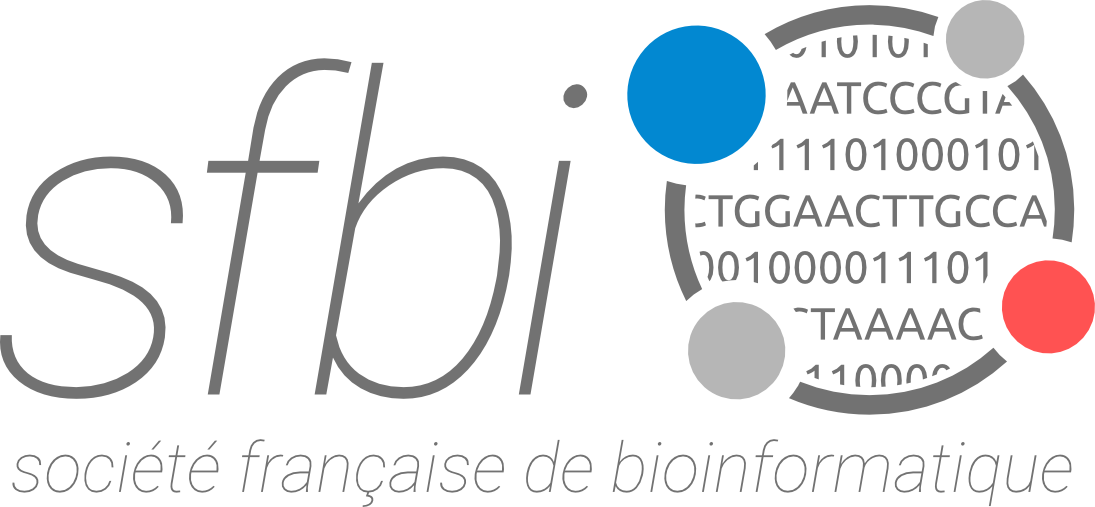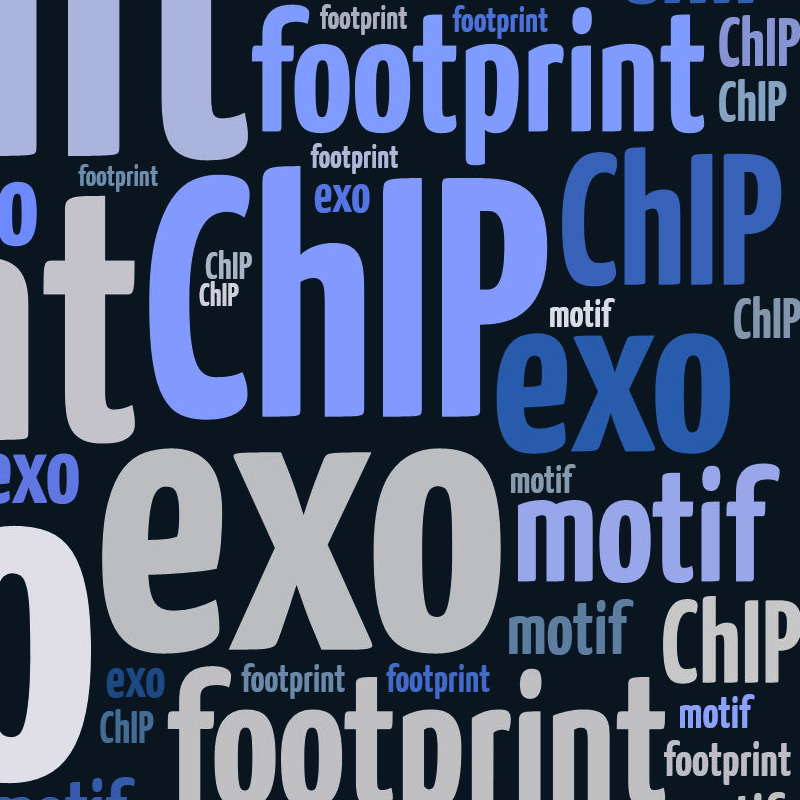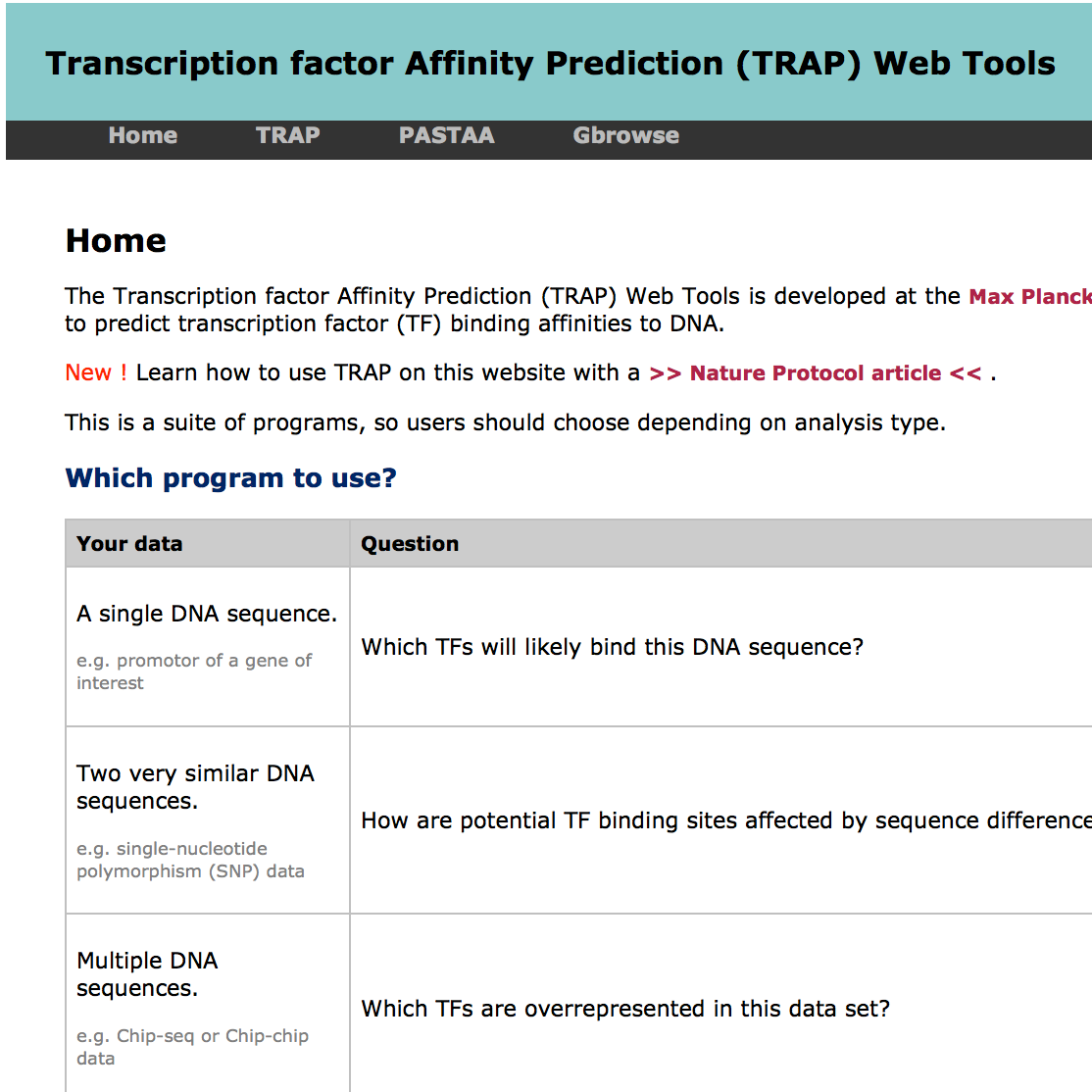Morgane Thomas-Chollier
Education and Academic positions
- 2020- Present : Co-head GenomiqueENS core facility of Ecole normale supérieure PSL
- 2012- Present : Associate Professor (Maitre de Conference) at Ecole normale supérieure PSL. Research institute : IBENS
- 2017 : Junior Member of Institut Universitaire de France (IUF), promotion 2017
- 2016 : Habilitation à Diriger des Recherches [abstract and full PDF]
- 2009 - 2012 : Postdoc Fellow
- Research team : Department of Computational Molecular Biology (Gene Regulation Group) headed by Martin Vingron, within Max Planck Institute for Molecular Genetics, Berlin Germany.
-
2008 - 2009 : Postdoc
- Research team : Laboratoire de Bioinformatique des Génomes et Réseaux (BiGRe) - (Genomes and Networks Bioinformatics) headed by Jacques van Helden, Brussels, Belgium.
- 2004 - 2008 : PhD in Bioinformatics
- Joint diploma between Université Libre de Bruxelles (ULB) and Vrije Universiteit Brussels (VUB) , Bruxelles, Belgium.
- Supervisors : Luc Leyns (CEGE, VUB) & Jacques van Helden (BiGRe, ULB), and Valérie Ledent (formerly in Belgian EMBnet Node).
 Humboldt fellowship
Humboldt fellowship
Complementary education
- 2021-2022 : courses in Management "Animer une équipe et des hommes" from Dauphine-PSL (Université PSL école Interne)
Research
 As co-head of a genomics core facility, I am interested in how next-generation sequencing data are generated, shared and analyzed. On a technical level, I am interested in the approaches for single-cell analyses, particularly for poorly-annoted genomes and with long-read sequencing.
As co-head of a genomics core facility, I am interested in how next-generation sequencing data are generated, shared and analyzed. On a technical level, I am interested in the approaches for single-cell analyses, particularly for poorly-annoted genomes and with long-read sequencing.
 In addition to teaching at university, training of researchers/engineers to bioinformatics approaches is crucial for me.
In addition to teaching at university, training of researchers/engineers to bioinformatics approaches is crucial for me.
 My projects often involve predictions of binding regions for transcription factors (motif detection, de-novo motif discovery, ChIP-seq, ChIP-exo) and I am co-leader of the software suite RSAT.
My projects often involve predictions of binding regions for transcription factors (motif detection, de-novo motif discovery, ChIP-seq, ChIP-exo) and I am co-leader of the software suite RSAT.
 I keep a biological interest for the evo-devo field.
I keep a biological interest for the evo-devo field.
Publications
List of publications with HAL: ORCID : 0000-0003-2608-476XInternational and National conferences
- Keynote speaker at ISCB-Latin America SOIBIO BioNetMX 2022 November 2022 (Queretaro, Mexico).
- Invited speaker at Journees Ouvertes de Biologie, Informatique et Mathematiques (JOBIM2021) - Mini-Symposium "Where are we in the detection of DNA motifs involved in the regulation of transcription?" July 2021 (Paris/online, France).
- Invited speaker at Innovative bioinformatics for single-cell resolution data June 2019 (Lille, France).
- Journees Ouvertes de Biologie, Informatique et Mathematiques (JOBIM2018) July 2018 (Marseille, France).
- Invited speaker at INSERM workshop 245 Enhancer structure and function April 2017 (Bordeaux, France).
- Invited speaker at 6th Nuclear Receptor Meeting May 2016 (Paris, France).
- Invited speaker at Journées COMATEGE-SeqBio November 2015 (Orsay, France).
- Invited speaker at Bringing maths to Life October 2015 (Naples, Italy).
- Journees Ouvertes de Biologie, Informatique et Mathematiques (JOBIM2015) July 2015 (Clermont-Ferrand, France).
- Sixth Annual RECOMB/ISCB conference on Regulatory and Systems Genomics November 2013 (Toronto, Canada).
- The next NGS challenge May 2013 (Valencia, Spain).
- Invited speaker at INSERM workshop 212 Bioinformatics approaches to decipher genome regulation from high-throughput data October 2011 (Bordeaux, France)
- Invited speaker at 15th international Evolutionary Biology Meeting September 2011 (Marseille, France)
- EED2010 - 3rd Euro Evo Devo Conference July 2010 (Paris, France).
Software projects
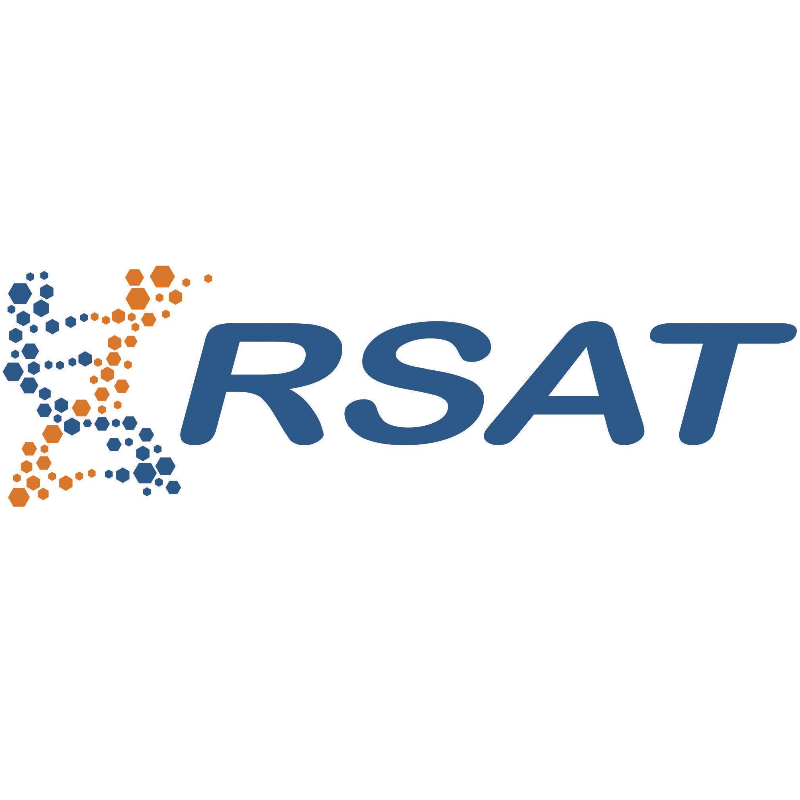 Santana-Garcia*,Castro-Mondragon* et al, NAR, 2022
Santana-Garcia*,Castro-Mondragon* et al, NAR, 2022Santana-Garcia et al, Comput Struct Biotechnol J, 2019
Nguyen*,Contreras-Moreira* et al, NAR, 2018
Castro-Mondragon JA et al, NAR, 2017
Medina-Rivera A*, Defrance M*, Sand O* et al, NAR, 2015
Thomas-Chollier M et al, Nature Protocols, 2012
Thomas-Chollier M et al, NAR, 2012
Thomas-Chollier M et al, NAR, 2011
Thomas-Chollier M*, Sand O* et al, NAR, 2008
Medina-Rivera A, Abreu-Goodger C, Thomas-Chollier M et al, NAR, 2011
Sand O, Thomas-Chollier M, van Helden J.Bioinformatics, 2009
Sand O, Thomas-Chollier M et al. Nature Protocols, 2008
Thomas-Chollier M*, Turatsinze J-V* et al. Nature Protocols, 2008
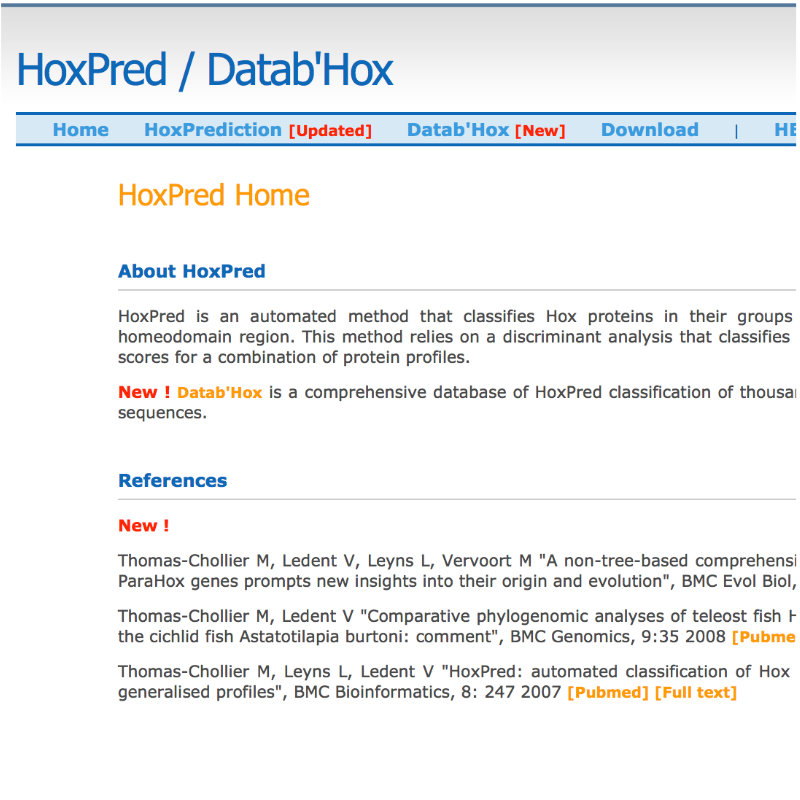 Thomas-Chollier M et al, BMC Evol Biol, 2010
Thomas-Chollier M et al, BMC Evol Biol, 2010Thomas-Chollier M et Ledent V, BMC Genomics, 2008
Thomas-Chollier M et al, BMC Bioinformatics, 2007
Teaching
- Classes at Ecole normale supérieure :
- L3 : Ateliers méthodologiques
- L3 : Génétique – Génomique – Bioinformatique
- L3 : Introduction aux sciences du vivant (Biologie pour non biologistes)
- M1 : Computational biology project
- M1+M2 : Mathematics and programming training
- M1+M2 : Soft skills
- M2: Functional genomic data analysis: epigenomics
- Current classes outside Ecole normale supérieure :
- Institut Pasteur : Ethics, good scientific practices and plagiarism
- Trainings for graduate students/researchers/engineers:
- Single-cell transcriptomics and epigenomics (SincellTE, Roscoff)
- Initiation au traitement des données de génomique obtenues par séquençage à haut débit (Ecole de bioinformatique AVIESAN IFB, Roscoff)
- ChIP-seq data analysis (UAEM, Cuernavaca, Mexico ; National University of Singapore ; VIB Bits, Leuven, Belgium ; Institut Pasteur cours Analyse des Génomes)
Being a bioinformatician in 2016 is both thrilling and frustrating.
Foreword HDR thesis.
Thrilling, as in less than a decade (barely since my PhD), we have been propelled into the ”Big Data” era of Biology [Stephens et al., 2015]. Improvements in sequencing technologies have led to an explosion of Genomics data. These billions of Terabytes (”Zettabytes”) of sequence data are raising challenges for computer scientists : data compression and storage, accessibility and distribution, development of more efficient algorithms to process these large datasets. The challenge for bioinformaticians is to keep up with these perpetual new developments to obtain biological insights from all these datasets, bridging the gap between computer scientists and experimental biologists. In just a few years, the global demand in bioinformatics skills has exploded, with several job advertisements posted every single day, solely in France (source: www.sfbi.fr) !
Today, it is obvious that there are not enough bioinformaticians. It has become ordinary to be approached by experimental biologists desperate to find ”someone to analyse their data”. That is when the frustration comes in, as bioinformaticians are too often considered as a mere service provider, contacted once the raw data are already produced to apply routine pipelines, regardless of the fact that most projects require customised analyses [Chang, 2015]. Frustration also comes from the lack of consensual definition of ’bioinformatician’ [Smith, 2015]. Within the spectrum of bioinformaticians, I came to consider myself as a computational (or dry) biologist, motivated by biological questions and using a computer as my bench. In this new Big Data era, collaboration between wet and dry biologists is becoming the new standard. Bioinformaticians should be involved early in the experimental design, and fair co-authorship on the publications should be customary. Evaluation criteria should be adapted for bioinformatician careers [Chang, 2015], acknowledging that working with multiple collaborators on very diverse biological questions is actually a sign of success rather than dispersion. The evaluation criteria need to be broadened to not only include the production of scientific software, but also recognize the maintenance of these software for the community [Singh Chawla, 2016]. Last, the frustration also comes when reading high-impact journal articles that have questionable and often unreproducible bioinformatic data analyses. During the peer-reviewing process, editors should enforce policies to ask reviewers if the manuscript should be sent to a bioinformatics specialist, similar to the policies often in place for statistics.
Training in bioinformatics has become crucial in recent years. On the one hand, by providing courses and training material [Lewitter, 2006] dedicated to researchers, to alleviate the current bottleneck of sequence data analysis. It is also important to provide user-friendly computer tools to experimentalists, who have the biological expertise to analyse their data, but often lack bioinformatics skills. On the other hand, it is necessary to engage the undergraduate biology students into interdisciplinary work and computational biology, so that the next generation of biologists and clinicians will have essential bioinformatics skills [Brazas et al., 2014].
Even if this dissertation focuses on my research work, teaching takes a huge part of my activity and motivation to be associate professor. I am gladly contributing to the above-mentioned teaching aspects by (i) my engagement in the AVIESAN/IFB school of bioinformatics for researchers, as well as in various trainings for biologists (Belgium, France, Singapore), (ii) developing usable bioinformatics tools (mainly RSAT) and training users via published protocols and workshops, (iii) as vice-president of the French Society of Bioinformatics (SFBI), co-organising the first national meet- ing dedicated to the teaching of bioinformatics at the undergraduate level, and (iv) at ENS, teaching computational biology to all biology students, and introduce them to the current challenges of the Big Data era.
References
Brazas, M. D., Lewitter, F., Schneider, M. V., van Gelder, C. W. G., and Palagi, P. M. (2014). A Quick Guide to Genomics and Bioinformatics Training for Clinical and Public Audiences. PLoS computational biology, 10(4):e1003510.Chang, J. (2015). Core services: Reward bioinformaticians. Nature, 520(7546):151–152.
Lewitter, F. (2006). Welcome to plos computational biology “education”. PLoS computational biology.
Singh Chawla, D. (2016). The unsung heroes of scientific software. Nature, 529(7584):115–116.
Smith, D. R. (2015). Broadening the definition of a bioinformatician. Frontiers in genetics, 6:258.
Stephens, Z. D., Lee, S. Y., Faghri, F., Campbell, R. H., Zhai, C., Efron, M. J., Iyer, R., Schatz, M. C., Sinha, S., and Robinson, G. E. (2015). Big Data: Astronomical or Genomical? PLoS Biology, 13(7):e1002195.
Women in Science
Disclaimer : All the information provided here is for general information only and is the expressed opinion of myself and not others. This includes (but is not limited to) my membership organisations and/or employers. Unless otherwise noted, I am the legal copyright holder of all written material on this website and it may not be used, reprinted, (partially) modified or published without my written consent. I make no warranties of any kind (expressed or implied) about the completeness, accuracy, reliability, suitability or availability of any information cited on this page.In 2004 when I started my PhD in bioinformatics, I ordered a Mac laptop as my working machine. When I received it, a senior postdoc in the lab told me "hey, you got a Linux for Barbie !".
Probably a great joke for the guys, but that day, I painfully discovered that being a woman would make a difference. That I would need to prove my skills to be considered. That I was not necessarily welcome in "their circle". After this, I have been extremely lucky with three open-minded mentors, who supported and guided me, lowering this bad feeling that nevertheless grew back as I became "older" in research.
Many discussions with female (and male !) scientists later, I'm convinced that this feeling is shared by many young women scientists, not just in bioinformatics, within France and abroad. I wished to do something about it, at my own level. As part of the SFBI, I have contributed to awareness of the low number of female invited speakers and chairs at Jobim, and acted to improve this. As a postdoc in Berlin, I gave a talk on women in sciences to raise awareness. In 2015, I attended the conference "Les Femmes dans le monde académique" to gain a more comprehensive understanding of the issues. I encouraged and helped my PhD students to apply to female-oriented funding schemes. In 2021, I gave a videoconference at the high school in my city to encourage girls to pursue studies in STEM, and explain unconscious biaises. I am convinced mentoring programs are a way to be part of a community of women, if you don't find incidentally great women on your path... Big thank you to Alexandra and Hélène.
Check out : Programme de mentorat des doctorantes Femmes & Sciences

